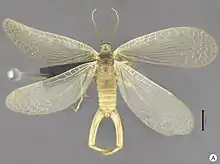Meropeidae
Meropeidae is a family of tiny scorpionflies within the order Mecoptera with only three living species, commonly referred to as "earwigflies" (or sometimes "forcepflies"). These include the North American Merope tuber, the Western Australian Austromerope poultoni, and the newly discovered South American A. brasiliensis.[1] The biology of these species is essentially unknown, and their larvae have never been seen.[2] The disjunct distribution suggests a common origin before the breakup of the ancient supercontinent of Pangaea. There are two undisputed extinct genera, Boreomerope antiqua[3] known from an isolated wing found in the Middle Jurassic Itat Formation of Siberia and Burmomerope[4][5] with three species from the Cenomanian aged Burmese amber. As such, the extant members of this family can be considered living fossils. These insects are also of interest due to their presumed basal position in the order Mecoptera. Thaumatomerope with four described species all from the Madygen Formation in Kyrgyzstan has historically sometimes been included within the family, it was placed into its own monotypic family, "Thaumatomeropidae." in 2002. [6]
| Meropeidae | |
|---|---|
 | |
| Merope tuber | |
| Scientific classification | |
| Kingdom: | Animalia |
| Phylum: | Arthropoda |
| Class: | Insecta |
| Order: | Mecoptera |
| Family: | Meropeidae Handlirsch 1906 |
| Genera | |
| |
The family name was spelt "Meropidae" in old literature but this clashes with the homonymous family name in birds for bee-eaters. The spelling of Meropeidae was adopted for the insect family by the ICZN in Opinion 140 of 1943.[7]
References
- Machado, R. J. P.; Kawada, R.; Rafael, J. A. (2013). "New continental record and new species of Austromerope (Mecoptera, Meropeidae) from Brazil". ZooKeys (269): 1–10. doi:10.3897/zookeys.269.4255. PMC 3592268. PMID 23653525.
- Friedrich, F.; et al. (2013). "The head of Merope tuber (Meropeidae) and the phylogeny of Mecoptera (Hexapoda)". Arthropod Structure & Development. 42 (1): 69–88. doi:10.1016/j.asd.2012.09.006. PMID 23078868. Retrieved September 26, 2014.
- V. Novokshonov. 1995. Der älteste Vertreter der Meropeidae (Mecoptera, Insecta). Palaeontologische Zeitschrift 69:149-152
- D. A. Grimaldi and M. S. Engel. 2013. The relict scorpionfly family Meropeidae (Mecoptera) in Cretaceous amber. Journal of the Kansas Entomological Society 86:253-263
- Zhao, Xiangdong; Zhang, Qingqing; Jarzembowski, Edmund A.; Chen, Lei; Wang, Bo (November 2016). "A new earwigfly from mid-Cretaceous Burmese amber (Mecoptera: Meropeidae)". Cretaceous Research. 66: 136–140. doi:10.1016/j.cretres.2016.06.008. ISSN 0195-6671.
- Wills, Allan (2007). "Earwig Flies? Ancient and Mysterious Insects". Western Wildlife. 12 (1): 5.
- "Meropidae (Aves): Proposed amendment of entry in official list of family-group names in Zoology. ZN(S.)2286". Bulletin of Zoological Nomenclature. 36 (3): 154. 1979.
| Wikispecies has information related to Meropeidae. |
| Wikimedia Commons has media related to Meropeidae. |
